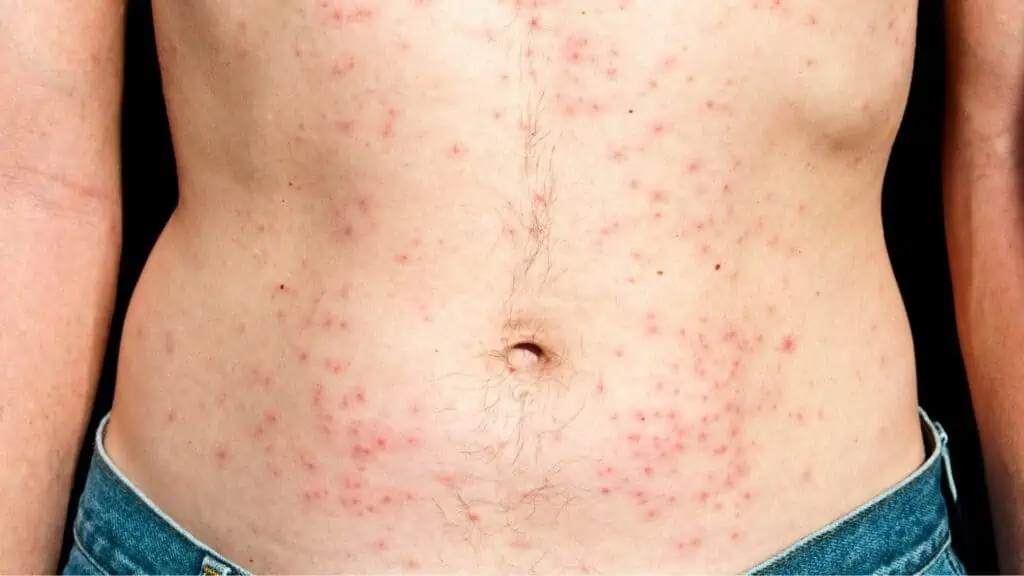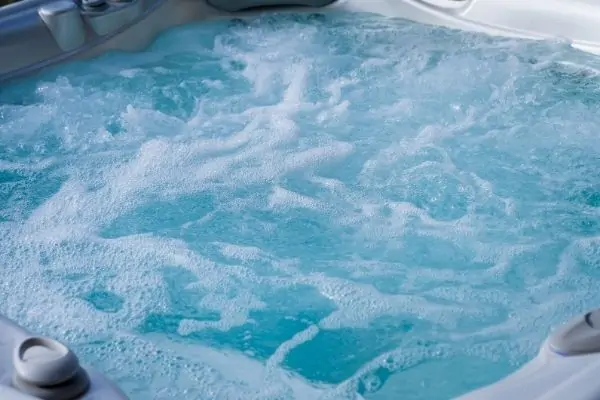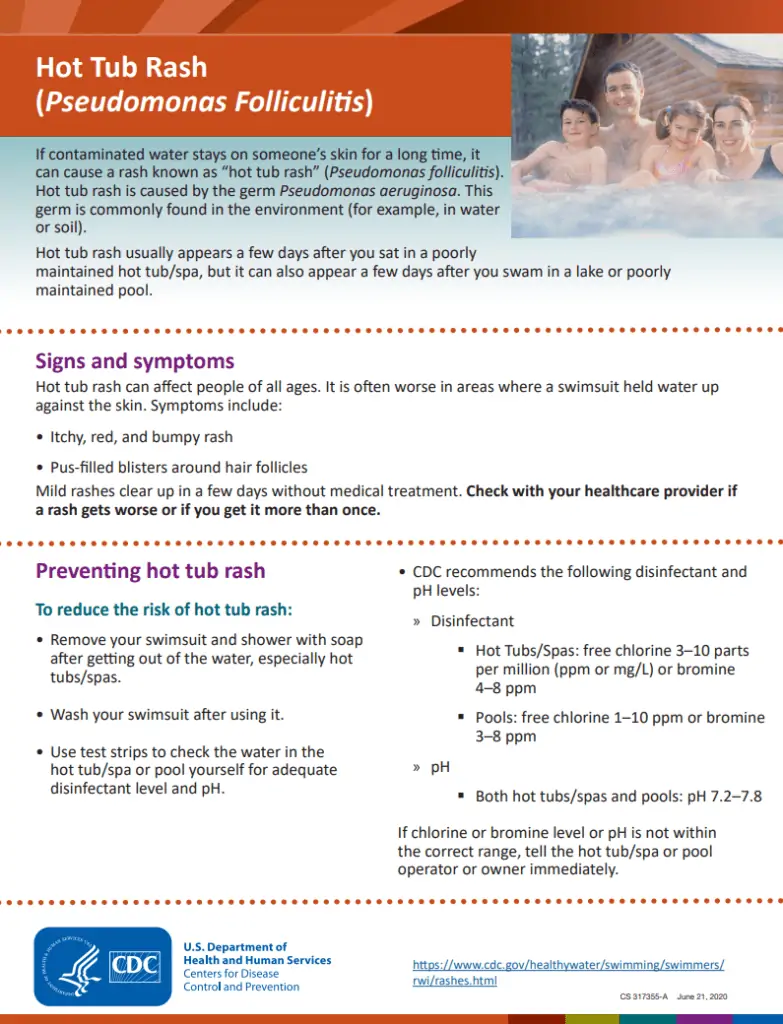Most people suffer no adverse reactions to using a hot tub, even for extended periods, while sitting directly exposed to the jets in the hot tub, firing out water and air.
However, others can suffer from mild skin irritation, which results in itchy skin. Normally, this is quite short-lived.
Apart from the jets in a hot tub causing skin problems for some users after use, others with particularly sensitive skin can experience problems due to the chemicals such as chlorine or bromine used to sanitize the hot tub’s water.

My hot tub makes me itchy – why?
One of the most probable causes of short-term skin itch when the skin has been exposed to the jets in hot tubs is its massaging action. Some people have a similar reaction to other forms of massage.
When the skin is massaged by the warm hot tub water (and air) from the jets, particularly for a prolonged period, the blood vessels close to the skin widen – a process known as Vasodilation.
In some cases, vasodilation can release histamines that can cause itchiness in the skin. In most individuals who experience this, it normally only lasts for a few minutes, perhaps up to 10 minutes, as the blood vessels return to normal and histamines are no longer released.
Anyone who experiences itchy skin for a much longer period should perhaps consider seeking medical intervention or, at the very least, limit their time in a hot tub with the jets running.
Wikipedia – Vasodilation
Other reasons your skin may be itchy after hot tub use
Some people have particularly sensitive skin, so they might experience itching due to something in the tub’s hot water.
The most common is sensitivity to the sanitizing chemicals used in hot tubs – chlorine and bromine.
Chlorine/Bromine
In a properly maintained hot tub, the spa chemicals are balanced correctly, so they are less likely to cause skin irritation.
But if the chlorine or bromine level is too high, then people who are sensitive to these chemicals or who have any form of dermatitis or other skin conditions might experience some skin itchiness.
Too much chlorine can also result in dry skin in some people.
Although chlorine is often present in tap water, you would not generally react to it when taking a bath or shower, as the chlorine level is much lower than in a hot tub or swimming pool.
Bacteria
It is possible that bacteria and germs are present in poorly maintained hot tubs, which may lead to conditions that cause the skin to itch and perhaps itchy spots.
One particular problem can be caused by the germ Pseudomonas aeruginosa, which can lead to the condition of pseudomonas folliculitis, also known as hot tub rash or hot tub folliculitis. As the name suggests, this can affect the hair follicles, causing an itchy rash. This can cause skin rashes, resulting in red marks and itching.
This is WebMD‘s advice to the question why am I so itchy after a hot tub?:
A long soak in a hot tub can give you itchy, bumpy, red spots. The troublemaker is often a germ called Pseudomonas aeruginosa. Spas are harder to keep clean than pools because high temperatures break down chemicals like chlorine faster. That makes a friendlier environment for bacteria. Always shower with soap right away after you’ve been in one, and wash your swimsuit, too.
This will often not be noticed for a few days after using the hot tub.

The Center for Disease Control (CDC) gives the following advice that should help prevent hot tub rash (hot tub folliculitis) – Hot Tub Rash (Pseudomonas/ Folliculitis):
- When getting out of the hot tub, you should shower with mild soap
- Wash your bathing suits after use
- Regularly check the hot tub water using test strips to check the pH and sanitizer levels are correct.
What should the pH and chlorine levels be in a hot tub or spa?
pH level
It is recommended that the pH in a hot tub be maintained between 7.2 and 8. This is slightly on the alkaline side of neutral which is 7.
This is also the ideal range for swimming pools.
Sanitizer level
The levels of chemicals in the form of sanitizer should be kept at:
- Free chlorine should be at 3–10 parts per million (ppm or mg/L).
- Bromine 4–8 ppm
For more information, you can read my related past – How much chlorine to add to a hot tub

Hot Tub Maintenance Course
I bought Swim University’s Hot Tub Maintenance Course a while after I bought my first hot tub and struggled to maintain it. It was very well spent and has paid for itself many times over the years as I have saved by not needing to use as many chemicals as I did previously.
Listen to our Hot Tub Course Review Podcast:
How to stop itching after hot tub use
There are a few ways to try and prevent skin irritation such as hot tub rash, chlorine rash or pseudomonas dermatitis that you might get from sitting in hot tubs or spas can include:
- One of the best ways to stop itchy skin is to make sure that when you get out after a soak you rinse off in a shower and wash your body using some form of mild soap. Ideally, you should shower in warm water rather than hot water.
- Limit your hot tub use and soaking time to 20 minutes each session.
- Don’t spend all your time with the jets pointing at just one part of your skin. Move around.
- Use non-chlorine shock if you want to use the hot tub soon after shocking.
CDC hot tub itchy skin advice
The Centre for Disease Control offers the following advice:

Related posts
For more information on how long you should soak in a hot tub – How long to stay in a hot tub
The complete guide to shocking a hot tub – How to shock a hot tub
If you are concerned about whether putting too much chlorine might cause it harm – Can too much chlorine damage a hot tub






Leave a Reply